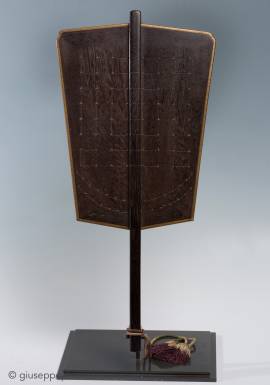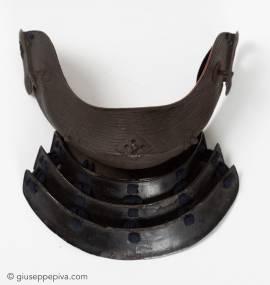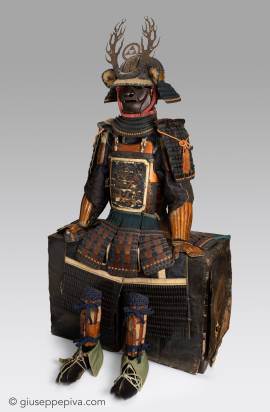Edo period, 19th century Wood with maki-e lacquer decorationsLength: 53,5 cmThe various implements used by samurai commanders to signal orders on the battered field or to direct troop movements were referred to as jineigu. Among them, the gunbai uchiwa, a fixed fan, was the equipment that was used by generals and daimyō and hence became a symbol of power.This gunbai is rather unusual among the common shapes. The straight lines and the absence of wide maki-e areas give in fact a sort of severe aspect, while the grain wood and the finely lacquered borders indicate the refined taste...
WORKS FOR SALE
Early Edo Period (1615-1867)Saika or Haruta School, 17th century A samurai mask of hanbo shape, covering half face and excluding the nose.The surface is finished with parallel lines called yasurime ("file marks”) and all rivets are decorated with applied iron ornaments (kirigane) either in the shape of a chrysanthemum or of lozenges, as typical from the Saika school of armorers. The Saika school was founded in the early 17th century by a group of armor-makers of the Haruta group who moved to Kii province, in the village of Saika.The tare (throat protection) is in...
PERIODMid Edo period (1615-1867), 18th century EXHIBITIONS"Samurai - Passato e Presente", Novara 2012LITERATUREG.Piva - S. Verrina, Samurai - Passato e Presente, cat. A2, Novara 2012 This authentic samurai armor of tosei gusoku type brings the coat of arms (kamon) with fish scale (uruko) design used by the Hirano clan, daimyō of Tawaramoto in Yamato province. The twelve-plates kabuto (helmet) of "pumpkin" shape (akoda-nari) is typical of this region, richly decorated with byakudan gold lacquer and...
Copyright © 2016 - giuseppe piva - VAT: 05104180962










